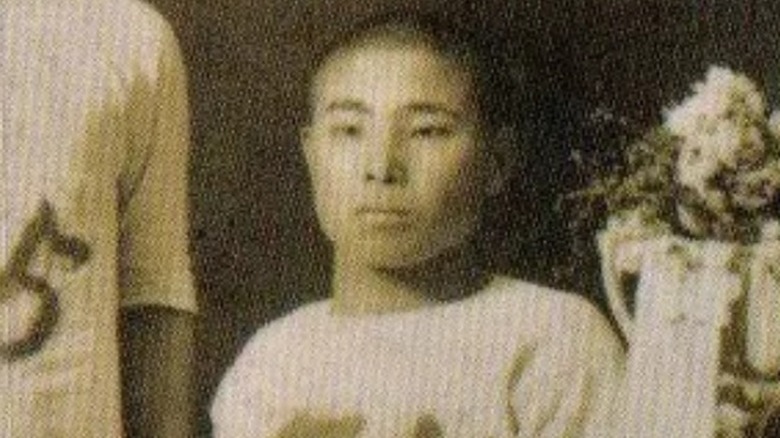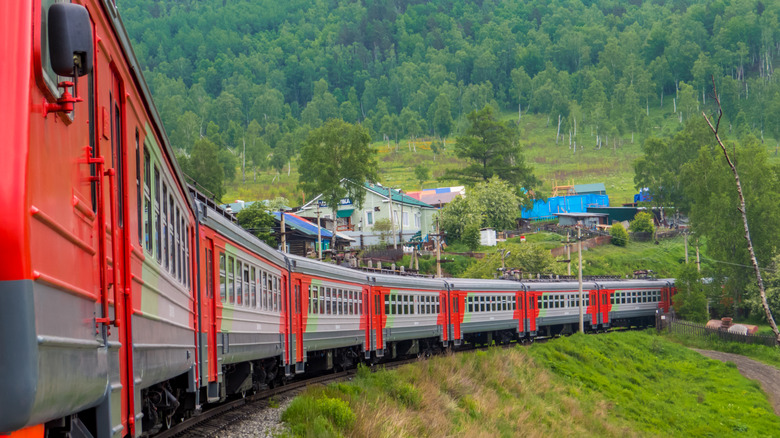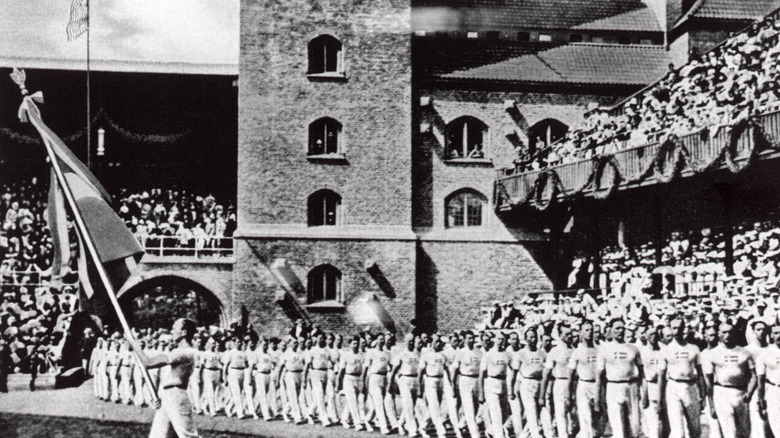The Slowest Marathon In History Technically Lasted More Than A Half Century
People run marathons for all sorts of different reasons. Some do it to prove to themselves that they have the discipline needed to train for such a grueling event, while others just want a car magnet that lets people behind them in traffic know that they're superior. For Shizo Kanakuri, it was about finishing something he had started over 50 years earlier, per Swedes In The States.
Kanakuri was a gifted runner who qualified for the 1912 Olympics in Stockholm where he was set to compete in the marathon, an event that plays homage to the Olympics' roots in Ancient Greece, per History. Despite his running ability, he's best remembered as the man who ran the longest marathon in history, with an elapsed time of over 54 years, and even led to him being declared missing by Swedish authorities, per Today I Found Out. It was all thanks to a series of unfortunate circumstances that outlined how difficult it could be for athletes to compete during the early years of the modern Olympic Games.
Kanakuri becomes one of Japan's top runners
Shizo Kanakuri grew up in rural town on Japan's third-largest island, Kyushu (via Britannica). He came from a family of sake brewers, and as a kid he honed his running abilities the old-fashioned way: by running four miles each way to and from school every day, according to The Washington Post.
"Kanakuri was a good runner and a very important runner in Japan," sports historian Kazuo Sayama told The Washington Post. Kanakuri was trained by another Japanese Olympic legend, Kano Jigoro. Jigoro founded the martial arts discipline judo back in the 1880s, per The Washington Post. When the Olympic Games were looking to expand in the early 20th century by inviting delegations from Asian countries for the first time, Kanakuri was one of two athletes to participate in the 1912 Olympic Games. Unfortunately, while his Olympic experience became the very memorable in the decades that followed, at the time, it was anything but smooth sailing.
Kanakuri's journey to the Olympics
In 1912, flight was still in its infancy, which meant that for Kanakuri to travel from Japan to Sweden he would need to use some alternate transportation methods. According to The Washington Post, Kanakuri's journey across Asia and into Scandanavia took over two weeks. It started by sailing across the sea of Japan to eastern Russia, where he hopped aboard the Trans-Siberian Railroad.
According to Britannica, the Trans-Siberian Railroad runs from Vladivostook in eastern Russia all the way to Moscow, spanning over 5,000 miles. While larger athletic delegations like that of the United States traveled by ship, Kanakuri was stuck on the cramped train and was only able to get a quick workout in whenever the train stopped. Things didn't get any better for Kanakuri when he finally made it to Sweden. Kanakuri probably wasn't all that familiar with Swedish food and the very real possibility that it wouldn't agree with his stomach.
Kanakuri's Olympic marathon begins
Shizo Kanakuri was dragging from the brutal combination of cross-continental travel and a sour stomach. To make matters worse, as Kanakuri made his way to the starting line, it was a sweltering 90 degrees in Sweden, per The Washington Post. Kanakuri gave it a valiant effort, even though the shoes he had brought with him weren't well-suited for the rough gravel that made up large portions of the Olympic marathon course.
According to Today I Found Out, more than halfway through the race, he collapsed because of the heat. A local family found him and kept him in their home until he woke up the next morning. When he woke up, he was so ashamed that he hadn't completed the race that he left the Sweden without notifying Swedish or Olympic officials. Those officials had no record of him finishing the race, so he was declared missing.
Of course, Kanakuri wasn't actually missing, and he returned to his native Japan. He went on to compete in the Olympics two more times, in 1920 and 1924. Still, his failure to complete his first Olympic race continued to eat away at him for decades.
Kanakuri finally finishes his first Olympic marathon
The Washington Post reports that the day after the 1912 Olympic marathon, Kanakuri wrote a journal entry: "It's the morning after my defeat. My heart is aching with regret for the rest of my life. It was the most significant day of my life. But failure teaches success, and I can only wait for the day with fair weather after the rain so that I can clean up my shame." That day finally came in 1967, when he was finally contacted by Swedish authorities. (Why it took so long for that to happen remains unknown.)
Arrangements were made for Kanakuri to return to Sweden to both finish the race and reunite with the family that helped him after he had passed out, per The Washington Post. Kanakuri's daughter later said that she was surprised to know how well known her father had become halfway around the world. In Sweden, the story of the lost marathon runner had become something of an urban legend.
Kanakuri finally finished his 1912 Olympic marathon run with a time of 54 years, 8 months, 6 days, 5 hours, 32 minutes, and 20.3 seconds. The end of Kanakuri's run was covered in Swedish media and when he was finished an announcer's voice could be heard over the loudspeaker saying, "This concludes all the events from the 1912 Stockholm Games."




